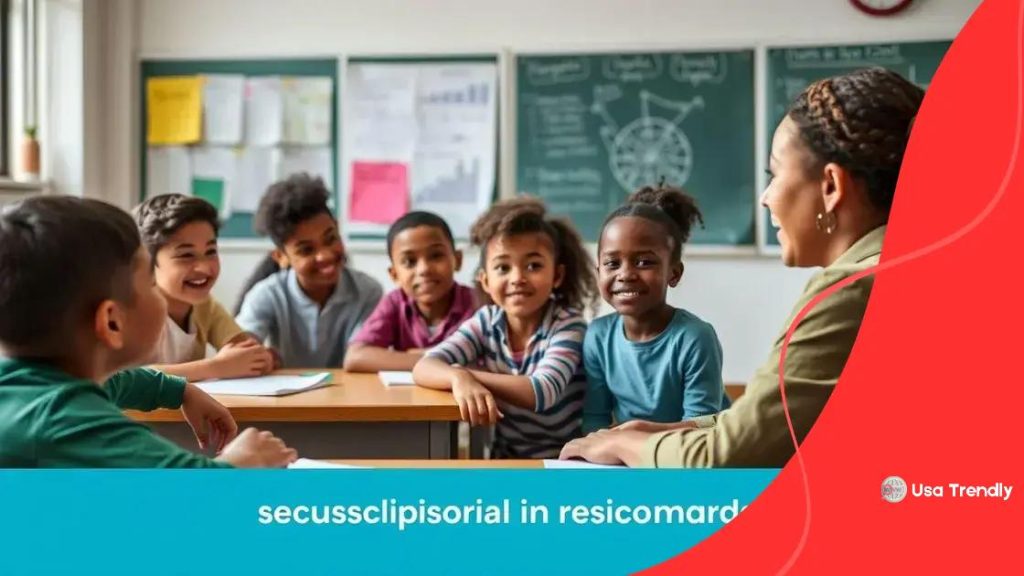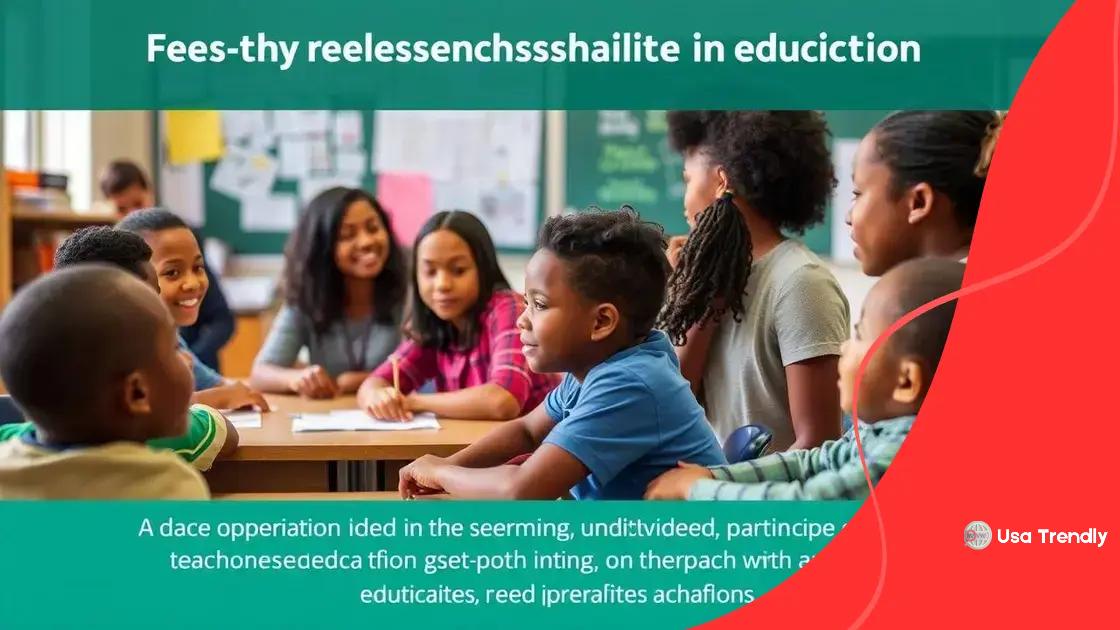Education policy reforms proposed by administration: what’s next?

Education policy reforms proposed by administration focus on enhancing equity, integrating technology in classrooms, and fostering community engagement to improve student learning outcomes and support teachers effectively.
Education policy reforms proposed by administration are stirring exciting discussions. These changes have the potential to reshape the learning landscape for students across the nation. But what does it really mean for educators and families? Let’s dive in to understand the implications.
key proposed reforms in education policy
There are several key proposed reforms in education policy that are under discussion. These reforms aim to reshape how education is delivered and accessed across various demographics. They focus on improving equity and quality in education, ensuring all students have the tools they need to succeed.
Improving Funding Equity
One major reform is aimed at enhancing funding equity across school districts. This change would allocate resources based on student needs rather than local property taxes.
- Increased funding for under-resourced schools.
- Equitable distribution of technology and teaching materials.
- Support for specialized programs to assist lower-income students.
By shifting the funding model, schools can provide more comprehensive support to those who need it most.
Curriculum Adjustments
Another critical area of reform involves curriculum adjustments. This includes integrating STEM education at earlier grades and ensuring arts education remains strong.
- Increased focus on science and technology skills.
- Inclusivity in teaching diverse cultural histories.
- Enhanced critical thinking and problem-solving skills.
These changes help students prepare for future challenges, making learning more relevant and engaging.
Moreover, training teachers in updated pedagogical methods is crucial. Adequate professional development ensures educators are equipped to deliver these new curricula effectively, fostering an environment of lifelong learning for students.
As these reforms unfold, community involvement becomes essential. Engaging parents and local organizations can create a feedback loop that continuously improves the education system.
potential impacts on students and teachers
The potential impacts on students and teachers from proposed education policy reforms can be profound. As these changes roll out, they promise to reshape the educational landscape in several ways.
Enhanced Learning Environment
One significant impact is the creation of a more inclusive and supportive learning environment. With funding focused on equity, schools can better meet the needs of diverse learners.
- Access to modern learning tools and resources.
- Smaller class sizes for more individualized attention.
- Support services like counseling and tutoring.
These enhancements can lead to improved student engagement and academic success.
Teacher Support and Development
For teachers, these reforms can bring about much-needed support. By investing in their professional development, schools enable teachers to implement new teaching strategies effectively.
- Access to ongoing training programs.
- Opportunities for collaboration with peers.
- Increased resources for classroom management.
This support not only helps teachers feel more confident but also enhances the overall quality of education they provide.
Moreover, with reforms focused on mental health and well-being, both students and teachers may experience a decrease in stress levels, leading to a more harmonious school environment. Empowering educators with tools to better manage classroom dynamics can significantly enhance teaching effectiveness.
Another aspect to consider is the long-term impact on student outcomes. Improved funding and curricula aimed at addressing learning gaps can provide all students, regardless of background, with a pathway to success. Ultimately, these reforms can redefine educational experiences for everyone involved, ensuring a brighter future.
how reforms aim to reduce disparities

The reform initiatives in education focus on how to reduce disparities among students from different backgrounds. These reforms are designed to ensure equitable access to high-quality education for all.
Targeted Resources for Underprivileged Areas
One of the key strategies involves redirecting resources to underfunded schools, particularly in areas with historically low academic performance. This includes:
- Increased funding to enhance facilities and materials.
- Salaries for teachers in high-need areas to attract top talent.
- Programs specifically tailored to assist disadvantaged students.
By addressing these disparities directly, schools can create a more balanced playing field for all students.
Data-Driven Approaches
Reforms also emphasize the importance of using data to identify trends in student performance. Schools can analyze this data to:
- Pinpoint gaps in learning and achievement.
- Adjust teaching strategies based on student needs.
- Develop targeted interventions for struggling students.
With a focus on continuous improvement, schools are better positioned to support those who need it most.
Moreover, training teachers to recognize and address the unique challenges faced by diverse student populations is essential. This professional development helps create an inclusive environment where every student feels valued and supported.
In addition, community partnerships play a vital role in these reforms. Engaging families and local organizations can help create a support system for students, making education a shared priority between schools and the community.
challenges faced during implementation
The challenges faced during implementation of education policy reforms can be significant. These obstacles often arise when trying to balance diverse needs and resources within the education system.
Resistance to Change
One major challenge is the resistance to change from various stakeholders. Teachers, parents, and even some administrators may be apprehensive about new methods. This resistance can come from:
- Fear of the unknown and uncertainty about new practices.
- Concerns over the effectiveness of proposed reforms.
- Attachment to established teaching methods.
Addressing these concerns through open communication and training is essential to foster a culture of trust and adaptability.
Insufficient Funding
Another critical hurdle is the issue of insufficient funding. Many reforms require substantial financial investment, which can often be lacking. This can lead to:
- Inadequate resources for implementing new programs.
- Inability to hire additional staff or provide training.
- Limited access to technology and materials necessary for modern teaching.
Securing stable funding is essential for the sustainability of these reforms.
Moreover, the implementation timeline can also pose a significant challenge. Many reforms are complex and require time for proper adoption, making effective planning vital. Schools need to be prepared for the transitional period during which old and new practices coexist.
Additionally, measuring the effectiveness of new reforms is not always straightforward. Schools must develop reliable metrics to assess changes while ensuring that they do not overwhelm teachers and students with assessments.
future of education policy in the administration
The future of education policy in the administration looks promising as new strategies emerge. These strategies aim to enhance learning outcomes and create a more equitable education system.
Emphasis on Technology Integration
One significant trend is the emphasis on technology integration in classrooms. Schools are increasingly adopting digital tools to:
- Facilitate remote learning and provide flexible educational options.
- Enhance engagement through interactive learning platforms.
- Prepare students for a technology-driven workforce.
By incorporating technology in various ways, education can become more personalized and responsive to student needs.
Focus on Holistic Education
Another essential aspect is the focus on holistic education, which considers both academic and emotional development. This approach promotes:
- Social-emotional learning to help students manage emotions.
- Life skills training alongside traditional subjects.
- A supportive school environment that nurtures well-being.
Integrating these elements can foster well-rounded individuals who are better equipped to handle life’s challenges.
Additionally, the role of community partnerships is likely to grow. Collaborations with local businesses and organizations can provide resources and real-world learning opportunities. Engaging with the community can enrich the educational experience for students.
Ongoing evaluation and adaptation will be crucial. As new challenges arise, policies must be flexible enough to evolve. Utilizing data analytics will help education leaders make informed decisions based on performance metrics.
FAQ – Frequently Asked Questions about Education Policy Reforms
What are the primary goals of the proposed education policy reforms?
The primary goals are to improve equity in education, enhance student engagement through technology, and support teachers in delivering effective instruction.
How does technology integration benefit students?
Technology integration allows for personalized learning experiences, enhances engagement, and prepares students for a digitally driven workforce.
What challenges might schools face in implementing these reforms?
Schools may encounter resistance to change, insufficient funding, and the need for ongoing evaluation to assess the success of the reforms.
Why is community engagement important in education policy reforms?
Community engagement helps build partnerships that provide additional support and resources, ensuring that the reforms meet the needs of all stakeholders.
SEE MORE CONTENT